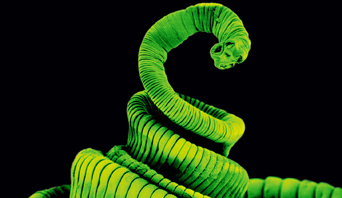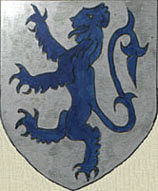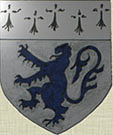Charles Bisset M.D.
Skelton's 18th Century Doctor and Military Engineer.
The 23 foot Worm.
In a letter dated 16 October 1785 Dr Charles Bisset describes treating two Skelton residents, who both suffered from worms.
|

The Human Tapeworm.
|
About ten years ago, the second son of the late John Appleton, a farmer near Skelton in Cleveland, aged about twelve years, became affected, soon after recovering from the small-pox by inoculation, with a sense of uneasiness in the epigastrium [upper region of the stomach], which, as it did not amount to an acute pain, was taken no notice of till a manifest intumescence, not very prominent, appeared in that region.
My advice being then desired, I pronounced it, on due examination, to be an imposthume [abscess] in the left lobe of the liver; for, as the patient had a tolerable appetite, and a good digestion, there was a moral certainty that the stomach was exempt from any disease, exclusive of an adhesion of its upper portion with the lower portion of the left lobe of the liver, which must then have taken place, and of its being compressed a little by the imposthumated lobe.
I recommended a milk diet, and told his father I made no doubt of its bursting, in process of time, into the stomach, which would afford the certain means of effecting a complete cure.
|
His father, in some short time after, boarded him in Stokesley, N Yorks, where he was put to school: he happened, how soon after I cannot say, to quarrel with one of his school companions, and, in fighting, his antagonist gave him a blow on the pit of his stomach, which burst the imposthume, and a very large .quantity of purulent matter was instantly thrown up, and for several days some of it appeared in his stools.
The boy's health was not much affected; he continued to have a tolerable appetite and a good digestion; but it was remarkable, that for three months after, he voided an immense quantity of long round worms, which almost induced me to believe they were bred in the bag of the imposthume; the rather, as all the usual vermifuge purges, and even bearsfoot, had failed to exterminate them; but having, at length, advised a course of Harrowgate water, that vermin quite disappeared.
This is one of nature's great and admirable medical resources, by means of which the matter that had formed in the left lobe of the liver had at all times a free and ready egress; digestion was very little disturbed, no hectic or purulent fever acceded, nor any accident, exclusive of the above-named worms, to retard or impede the cure; but I regard the worms as an extraordinary occurrence that had no connexion with the original disease.
A young man, a sailor, living at Seaton near Hartlepool, who had long been afflicted with the tape-worm, has taken the powder of male fern, with a dose or two of gamboge, at three different periods.
A piece of the worm, about five or six yards in length, was expelled by each course, which always improved his health, and the cucurbitines, or detached joints, disappeared; but each flattering truce terminated in seven or eight weeks, at the end of which period the detached joints always began to be voided as usual, to the patient's great disappointment.
I sent him a quantity of the powder, with some gamboge, made into pills, I think, in November last; but as I have not heard from him since, I apprehend he was lost in the great storm in January last, which proved so fatal and ruinous on this coast.
The wife of William Thompson, a farmer, living in Skelton in Cleveland, has been affected with the taenia [tapeworm] above twenty years.
About sixteen years ago, on taking two doses of gamboge [gum resin from S Asian tree], after premising some mercurials, she voided a worm that measured twenty-three feet, and four or five yards of another, which procured her a suspension of eight or nine weeks, no detached joints having been voided within that time.
As the gamboge operated with some violence, and she was always either pregnant or giving suck, I could not prevail with her to repeat it.
In the spring of 1781 I advised her to make trial of the powder of the root of male fern, which I assured her would occasion no disorder.
Half an ounce of -the powder was divided into eight doses, of which she took one in warm water, sweetened with honey, every night and morning: on the fifth night she took a drachm of the powder, and another drachm early next morning, which proved purgative, and expelled four or five yards of a tape-worm, with a great number of detached joints and after omitting one day, she took a dose of gamboge, which operated sharply, but did not expel a single detached worm.
Immediately after this course an inflammatory pustular eruption broke out all over her body; the cucurbitines, or small flat worms, disappeared;
a pain at her stomach, to which she had long been subject, quite ceased; she was completely healthy, exclusive of the eruption, which soon dried and peeled off, and flattered herself with the hope of being quite freed from that vermin; but, to her great disappointment, after an interval of seven weeks, they began to be voided as usual.
She repeated the same course in about a year after, with the like temporary success.
I asked the patient if the detached joints that were voided while she was taking the powder were dead or , liying; she said, that those that were expelled along with the large portion of an entire worm, appeared to her to be dead:
hence it may be inferred, that the powder of the male fern is poisonous to that worm, but not in so great a degree as at all times to be equal to the extermination of it.
Persons who have a tape-worm generally void at the rate of ten detached joints in twentyfour hours; for these make their egress at any time without a motion, though they are mostly voided with the stools; whence it may be inferred, that the worm vegetates, or is increased in length, five inches every day, supposing each detached living joint to be half an inch Jong; but they are generally longer.
The learned and judicious Dr. Simmons has favoured the public with a well written pamphlet on the Taenia, of which he exhibits two sorts: the lata and cucurbitina. As I never saw the former, it should seem to be an uncommon occurrence in this kingdom.
Young turbots.that are caught about the end of June, have often, I supposei tape-worms in their intestines, as two out of three that were opened by my maid-servant, in June 1781, had each a tape-worm in its gut; but the maid had unfortunately taken them out before I had an opportunity of examining the head, and of observing if it was fixed in the villous coat.
They were both very lively, their motion consisting in extending and contracting their joints alternately; and it is probably this motion that occasions the separation of the long joints at the extremity of the tail.
I perceive you are fully employed, and you must be very happily so, in the construction of your villa, and the arrangement of your botanical garden. I have, perhaps, been not less busy, but with less advantage, during eight months past, in executing a concise system of fortification, which will be illustrated with above twenty new designs, which are finished, and will make a handsome manuscript, for it will not be published.
I am, respectfully, Dear Sir, Your most obedient humble servant,
Charles Bissett.
|
|



